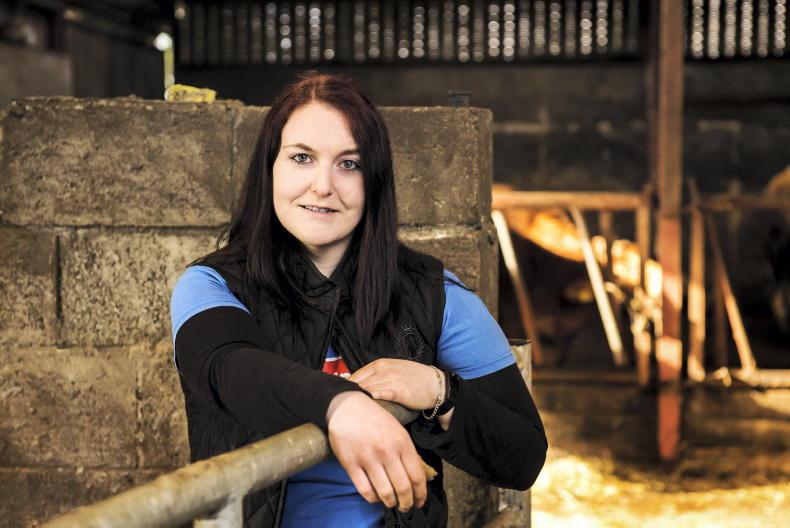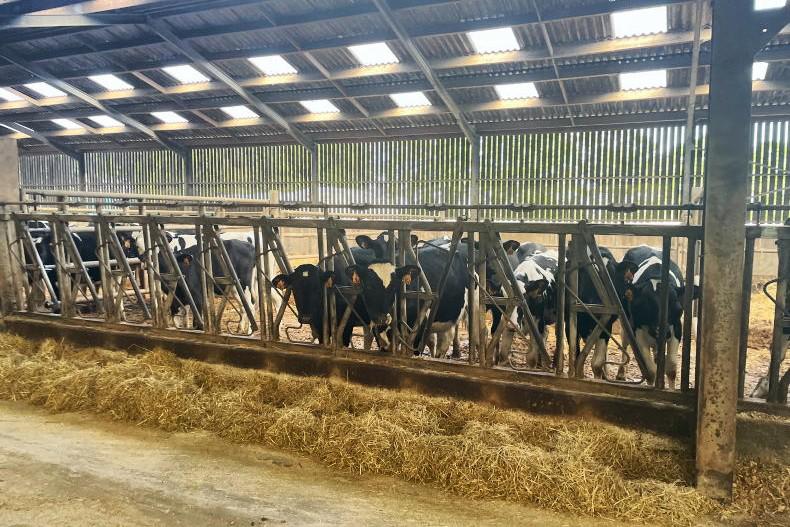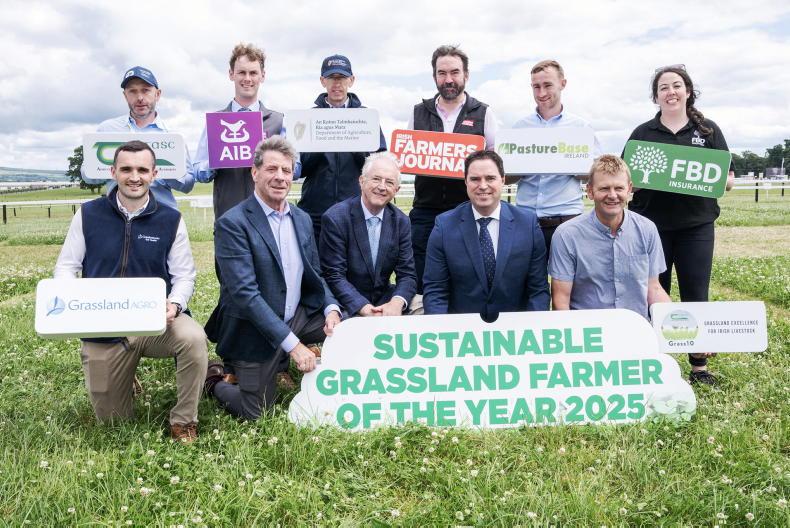Being good in all areas judged is what won Patrick O’Neill the Grassland Farmer of the Year award for 2023, according to Teagasc’s John Maher. Patrick hosted a large crowd of farmers from around the country last week on his farm just outside Edgeworthstown in Co Longford, for an open day as part of the Grass10 competition.
Farming 74ha of mostly good soils, the whole farm stocking rate is 2.1 cows/ha. Included in this is 10ha of outside land used for silage, but all the heifers are kept at home and most of the silage comes from the 64ha home farm.
At 115 cows, the argument could be made that the farm could carry more cows, but Patrick thinks they have the balance right now in terms of cow numbers, financial return and work-life balance. Grass growth over the last three years has ranged from 13.1t DM/ha in 2021, 12.8t in 2022, 11.9t in 2023 and 5.5t DM/ha so far in 2024.
At the same time, fertiliser nitrogen use on the milking block ranged from 175kg N/ha to 134kg N/ha, with 115kg N/ha spread to date. One of the key take-away messages from the event was that Patrick is keen to get the farm back growing over 13t DM/ha again and that he feels the lower nitrogen rates of 134kg N/ha in 2022 and 140kg N/ha in 2023 cost the farm in terms of grass growth.

Patrick O'Neill chatting with John Maher at the farm walk.
With good levels of clover across most of the milking platform, Patrick utilises the nitrogen fixing ability of clover to replace the reliance on chemical nitrogen, but finding the balance is a learning process, he says.
“We cut back the nitrogen too hard and too early in the year in the past, so now we are keeping going with full rate and only reducing nitrogen when the clover is growing well.”
From this time of year on, fields with good levels of clover won’t be getting chemical nitrogen, but instead will be targeted with watery slurry after grazing, which is applied with the slurry tank and dribble bar. In the O’Neill case, watery slurry is soiled water/dairy washings mixed with slurry, so it’s a bit stronger than pure soiled water.
Patrick joined his father Tom in a farm partnership in 2013. At the time they were farming 40ha with 60 cows and beef cattle. With quotas going, Patrick says he knew the farm had potential to generate more income and his goal was to get the demand for grass up to what the farm could grow.
This involved growing more grass and breeding more cows. Soil fertility was low, so this was where the focus was for the first few years, spreading mostly 18:6:2 fertiliser and applying 80 to 100t of lime per year. Now, all of the milking platform is at index three and four for phosphorus and potash, and on target for lime, which is undoubtedly a big help in retaining clover.
With such good soil fertility, the farm has no allowance for phosphorus any more, so this is something Patrick has to manage carefully with more targeted slurry application and more regular soil sampling, to pick up reductions in phosphorus quickly, which will then feed into a higher P allowance.

The field of red clover and ryegrass was sown on 10 May.
Clover
Patrick’s interest in clover began in 2018. As he says himself he was more interested in the milk solids lift, rather than the ability to reduce nitrogen. However, the latter benefit has turned out to be a big advantage with the way fertiliser regulations and costs have changed.
Interestingly, oversowing clover has been a big success on the farm, with an Einbock tine harrow the method of choice. Patrick uses a mix of both reseeding and oversowing to get clover established, with reseeding targeted on older swards and oversowing targeted on more recently reseeded fields that need a lift in clover content.
“I find that the end of April or early May is better around here for oversowing than early April. Soil temperatures are lower and soil is still wet here in April, so reseeding or oversowing a little later in the summer works a big better,” he says.
Approximately 10% of the farm is oversown with clover each year and another 8% to 10% reseeded. This years’ reseeds are a red and white clover sward in a silage field, which he plans to cut for bale silage three times per year and feed the bales to youngstock over the winter.
The seeds containing 7kg of ryegrass per acre, 4kg of red clover and 1kg of white clover per acre were sown on 10 May and sprayed last week. Patrick intends taking a light grazing off it in the coming days. This is the first time he has sown red clover as he is keen to try it out.
The field got farmyard manure and two bags/acre of 10:10:20 at sowing, and will get 2,000 to 3,000 gallons/acre of watery slurry.
Patrick hasn’t yet encountered any issues with bloat. He uses bloat oil in the water through an automated trough dispenser when clover contents are high and will also use 12-hour strip wires, but says that clover contents rarely get above 40% to 50% on his farm.

There was a big turnout at the event.
Cows
Back in 2013 most of the herd were bred from stock bulls and EBI was on the floor. By focusing on AI and EBI the herd has improved and now has an EBI of €217. Patrick says that in hindsight he would have been better off buying in high-EBI replacements rather than breeding the existing herd up, as he’d be further ahead now.
While fertility performance is very good, there was a bit of discussion around the milk solids production. On average, over the last five years the herd delivered 424kg MS/cow and this was down to 410kg MS/cow last year, as the herd was dried off from mid-November due to the bad weather.
There was 870kg of meal fed per cow last year, which is higher than Patrick would like and with 470kg/cow fed to date, it looks like it’ll be higher in 2024, with similar levels of milk solids. The sense I was getting from some of the Teagasc speakers was that the modest level of production per cow was something that needed to be improved. I asked Patrick if the farm was under financial pressure because the milk solids per cow were below the target of 500kg MS/cow.
“Not at all, things are comfortable. We run a simple, no frills farm and our costs are low,” he says.
That’s not to say that he wouldn’t like more production, but it has to come from the right place. It would be easy to feed another 500kg to 600kg of meal, but that would come at a big cost. Patrick has identified a couple of areas where more production could be achieved at lower cost. He says the quality of the silage available to milking cows wasn’t good enough when the weather let him down last autumn and this spring and as a result cows didn’t peak well in 2023 or 2024. He says that grass allocations in spring and early summer were probably a bit tight, so he is going to try and increase allocation while still maintaining good utilisation.
The herd is still young, with an average of three lactations, so as the herd matures to 3.8 to 3.9 lactations the milk production should increase with it. Between these factors, continuous improvement in EBI and a bit of luck with weather he should see steady gains in milk solids over the coming years at little additional cost to the farm business.
Being good in all areas judged is what won Patrick O’Neill the Grassland Farmer of the Year award for 2023, according to Teagasc’s John Maher. Patrick hosted a large crowd of farmers from around the country last week on his farm just outside Edgeworthstown in Co Longford, for an open day as part of the Grass10 competition.
Farming 74ha of mostly good soils, the whole farm stocking rate is 2.1 cows/ha. Included in this is 10ha of outside land used for silage, but all the heifers are kept at home and most of the silage comes from the 64ha home farm.
At 115 cows, the argument could be made that the farm could carry more cows, but Patrick thinks they have the balance right now in terms of cow numbers, financial return and work-life balance. Grass growth over the last three years has ranged from 13.1t DM/ha in 2021, 12.8t in 2022, 11.9t in 2023 and 5.5t DM/ha so far in 2024.
At the same time, fertiliser nitrogen use on the milking block ranged from 175kg N/ha to 134kg N/ha, with 115kg N/ha spread to date. One of the key take-away messages from the event was that Patrick is keen to get the farm back growing over 13t DM/ha again and that he feels the lower nitrogen rates of 134kg N/ha in 2022 and 140kg N/ha in 2023 cost the farm in terms of grass growth.

Patrick O'Neill chatting with John Maher at the farm walk.
With good levels of clover across most of the milking platform, Patrick utilises the nitrogen fixing ability of clover to replace the reliance on chemical nitrogen, but finding the balance is a learning process, he says.
“We cut back the nitrogen too hard and too early in the year in the past, so now we are keeping going with full rate and only reducing nitrogen when the clover is growing well.”
From this time of year on, fields with good levels of clover won’t be getting chemical nitrogen, but instead will be targeted with watery slurry after grazing, which is applied with the slurry tank and dribble bar. In the O’Neill case, watery slurry is soiled water/dairy washings mixed with slurry, so it’s a bit stronger than pure soiled water.
Patrick joined his father Tom in a farm partnership in 2013. At the time they were farming 40ha with 60 cows and beef cattle. With quotas going, Patrick says he knew the farm had potential to generate more income and his goal was to get the demand for grass up to what the farm could grow.
This involved growing more grass and breeding more cows. Soil fertility was low, so this was where the focus was for the first few years, spreading mostly 18:6:2 fertiliser and applying 80 to 100t of lime per year. Now, all of the milking platform is at index three and four for phosphorus and potash, and on target for lime, which is undoubtedly a big help in retaining clover.
With such good soil fertility, the farm has no allowance for phosphorus any more, so this is something Patrick has to manage carefully with more targeted slurry application and more regular soil sampling, to pick up reductions in phosphorus quickly, which will then feed into a higher P allowance.

The field of red clover and ryegrass was sown on 10 May.
Clover
Patrick’s interest in clover began in 2018. As he says himself he was more interested in the milk solids lift, rather than the ability to reduce nitrogen. However, the latter benefit has turned out to be a big advantage with the way fertiliser regulations and costs have changed.
Interestingly, oversowing clover has been a big success on the farm, with an Einbock tine harrow the method of choice. Patrick uses a mix of both reseeding and oversowing to get clover established, with reseeding targeted on older swards and oversowing targeted on more recently reseeded fields that need a lift in clover content.
“I find that the end of April or early May is better around here for oversowing than early April. Soil temperatures are lower and soil is still wet here in April, so reseeding or oversowing a little later in the summer works a big better,” he says.
Approximately 10% of the farm is oversown with clover each year and another 8% to 10% reseeded. This years’ reseeds are a red and white clover sward in a silage field, which he plans to cut for bale silage three times per year and feed the bales to youngstock over the winter.
The seeds containing 7kg of ryegrass per acre, 4kg of red clover and 1kg of white clover per acre were sown on 10 May and sprayed last week. Patrick intends taking a light grazing off it in the coming days. This is the first time he has sown red clover as he is keen to try it out.
The field got farmyard manure and two bags/acre of 10:10:20 at sowing, and will get 2,000 to 3,000 gallons/acre of watery slurry.
Patrick hasn’t yet encountered any issues with bloat. He uses bloat oil in the water through an automated trough dispenser when clover contents are high and will also use 12-hour strip wires, but says that clover contents rarely get above 40% to 50% on his farm.

There was a big turnout at the event.
Cows
Back in 2013 most of the herd were bred from stock bulls and EBI was on the floor. By focusing on AI and EBI the herd has improved and now has an EBI of €217. Patrick says that in hindsight he would have been better off buying in high-EBI replacements rather than breeding the existing herd up, as he’d be further ahead now.
While fertility performance is very good, there was a bit of discussion around the milk solids production. On average, over the last five years the herd delivered 424kg MS/cow and this was down to 410kg MS/cow last year, as the herd was dried off from mid-November due to the bad weather.
There was 870kg of meal fed per cow last year, which is higher than Patrick would like and with 470kg/cow fed to date, it looks like it’ll be higher in 2024, with similar levels of milk solids. The sense I was getting from some of the Teagasc speakers was that the modest level of production per cow was something that needed to be improved. I asked Patrick if the farm was under financial pressure because the milk solids per cow were below the target of 500kg MS/cow.
“Not at all, things are comfortable. We run a simple, no frills farm and our costs are low,” he says.
That’s not to say that he wouldn’t like more production, but it has to come from the right place. It would be easy to feed another 500kg to 600kg of meal, but that would come at a big cost. Patrick has identified a couple of areas where more production could be achieved at lower cost. He says the quality of the silage available to milking cows wasn’t good enough when the weather let him down last autumn and this spring and as a result cows didn’t peak well in 2023 or 2024. He says that grass allocations in spring and early summer were probably a bit tight, so he is going to try and increase allocation while still maintaining good utilisation.
The herd is still young, with an average of three lactations, so as the herd matures to 3.8 to 3.9 lactations the milk production should increase with it. Between these factors, continuous improvement in EBI and a bit of luck with weather he should see steady gains in milk solids over the coming years at little additional cost to the farm business.













SHARING OPTIONS